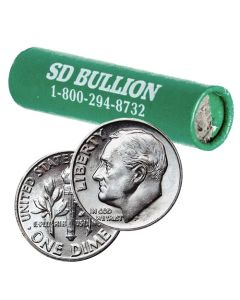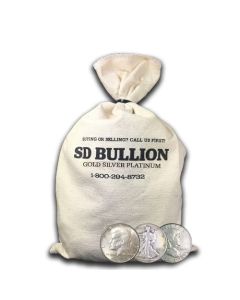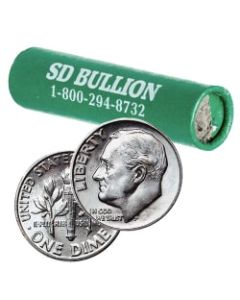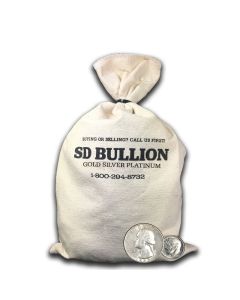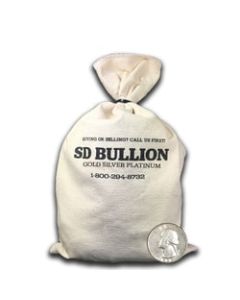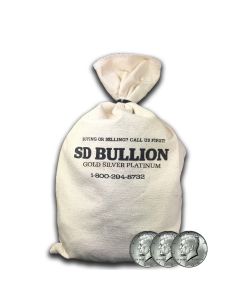-

90% Constitutional (Junk) Silver
-

90% Silver Half Dollars
-

90% Silver Dollars
-

40% Silver
-

90% Silver Dimes
-

90% Silver Quarters
Junk Silver: Top Sellers
Junk Silver Coins For Sale | Buy 90% Silver Coins Online
Junk Silver—also known as 90% Constitutional Silver—remains one of the simplest, most affordable, and most trusted ways to buy physical silver. They offer a practical option to grow assets with reliable silver content, strong liquidity, and easy verification.
Unlike modern silver bullion coins, Junk Silver consists of pre-1965 90% silver coinage that once circulated as everyday money. Their intrinsic value, backed by the enduring trust of the U.S. Mint, continues to make them popular for long-term wealth protection, preparedness planning, and low-premium stacking.
Highlights
-
Genuine pre-1965 U.S. silver coins crafted with 90% silver
-
Affordable premiums compared to other silver bullion products
-
Highly trusted, broadly recognized U.S. mintage
-
Fractional sizes ideal for barter, trading, or emergency use
-
Historical appeal without high premiums
-
Available as rolls, bags, and bulk face-value lots
Constitutional Silver
Junk Silver, or Constitutional Silver, includes pre-1965 dimes, quarters, half-dollars, and dollars minted in a 90% silver / 10% copper composition. They circulated widely until rising silver prices made their melt value exceed their denomination, prompting the public to save them rather than spend them.
These US 90 silver coins remain legal tender, though they are now worth their metal content rather than their imprinted denomination. Investors favor them for their reliability, recognizability, and fixed Troy oz weight per increment.
Whether you’re stacking Mercury dimes, Walking Liberty half dollars, or a Morgan Silver Dollar, these pieces carry decades of history and the trusted craftsmanship of the U.S. Mint without collectible premiums.
Types of Junk Silver Coins We Sell
SD Bullion offers a comprehensive selection of pre-1965 90% junk silver coins, including:
|
90% Silver Dimes |
90% Silver Quarters |
90% Silver Half Dollars |
90% Silver Dollars |
Other Junk Silver Types |
|
· Mercury Dimes · Liberty Head Dimes · Roosevelt Dimes |
· Washington Quarters · Liberty Head Quarters · Standing Liberty Quarters |
· Liberty Head · Walking Liberty Half Dollars · Franklin Half Dollars · Early Kennedy Half Dollars (pre-1965) |
· Peace Dollar · Morgan Dollar |
· 40% Silver Half Dollars (minted 1965–1970 and select 1976 issues) · 35% Silver War Nickels (1942–1945) |
Although some may show signs of wear and tear, the metal content in each sample remains the key to their long-term value and strong market demand.
Collectibility and Numismatic Value
When buying junk silver coins, it’s essential to distinguish them from collector or numismatic items.
Junk Silver is priced purely for silver content, not for dates, mint marks, rarity, or condition. Even with visible wear, their value tracks closely with the spot price and corresponding melt value.
By contrast, collectible coins, such as the 1971 40% Silver Eisenhower Dollar, command higher premiums because they were issued as special issues rather than released for circulation and are considered numismatic rather than bullion.
This difference helps buyers separate investment silver from collector coins whose prices depend on scarcity rather than weight.
Role in the Bullion Industry
Both pre-1965 90% silver coins and 40% silver half dollars retain their official currency status, but their value is based on their metal content, not their denominational value.
A single 90% silver dime contains about 2.25 grams of silver, making these smaller samples particularly useful for potential barter during financial stress or uncertainty.
Investment Value
Junk Silver has long served as a hedge against inflation, currency weakness, and declining purchasing power. Because silver is a tangible asset with intrinsic value, it tends to remain valuable across decades of economic change.
These coins also offer:
-
Privacy
-
Portability
-
Independence from digital financial systems
-
A real asset backed by silver, not a cupro-nickel alloy
For many investors, US 90 silver is a stable, low-premium, long-term wealth-preservation tool.
Low Premium
Junk Silver earns its name from circulation marks and lack of collectible premium, not from low quality. In fact, they offer some of the lowest premiums among physical silver products.
Because silver is more affordable than gold, Junk Silver remains an accessible entry point for buyers wanting the most metal for their money.
Silver Content and Value Retention
Each coin contains a precise amount of silver, giving it intrinsic value that holds up well during economic downturns. Even decades after purchase, Junk Silver maintains reliable resale value, strong buyer demand, and consistent alignment with its melt value.
Whether you accumulate two coins, two bags, or a full $1,000 Face Value bag, Junk Silver remains a dependable component of a diversified silver strategy.
Why Investors Buy Junk Silver
-
Low premiums over spot price
-
Easy to store, trade, and verify
-
Strong resale demand and broad market acceptance
-
Ideal for emergency barter due to smaller denominations
-
Long history of trusted U.S. coinage, free from cupro-nickel alloy used in modern clad coins
Buying Junk Silver
Investing in Junk Silver is possible in multiple formats, depending on budget and stacking goals:
Face Value Rolls
You can buy 90% Silver Rolls in increments as small as $5, which generally include 50 silver dimes totaling 3.575 troy oz.
Bulk Bags
For larger positions, 90% Silver Bags offer excellent opportunities. A bag has mixed dimes, quarters, and half dollars in increments of:
-
$100 face value
-
$500 face value
-
$1,000 face value
These bulk options help accumulate bullion efficiently while maximizing ounces per dollar.
Ready to Strengthen Your Silver Portfolio?
Junk Silver remains one of the most reliable precious metals investments available.
Shop Junk Silver Coins online at SD Bullion Today.


SD Bullion CEO Chase Turner's Overview
Junk Silver is really not junk. In times of silver supply constraints, it’s some of the most highly sought after silver coins on the market. Why? It’s simple. These coins haven’t been produced since 1964. So there’s really limited supply when it comes down to it.
Also pre-65 silver tells the silver story in real life. Our country’s currency used to be silver and gold. But as the paper currency experiment took over and crushed the value of purchasing power, it became more expensive in base metals terms to produce silver dimes and quarters. Therefore, starting in 1965 the silver was removed from dime and quarter minting. So owning pre-65 Junk Silver not only gives investors limited silver owning, but it’s also an important piece of US monetary history.
FAQs
Is junk silver worth anything?
Junk silver holds real value because each sample has a specific amount of silver, and its worth tracks the daily silver spot price. These pre-1965 U.S. coins were minted before Congress removed silver from circulating currencies, making them intrinsically valuable. Since dimes, quarters, half dollars, and dollars all have different silver weights, their prices vary based on their actual metal content.
Can you get junk silver at a bank?
Banks rarely sell junk silver today. They have been out of circulation for decades, so they’re typically unavailable through financial institutions. Instead, buyers find them through coin shops, auctions, private sellers, and especially reputable online bullion dealers. Purchasing from trusted sources, such as SD Bullion, matters, as authentication and consistent pricing help protect buyers from fakes or misrepresented items commonly found in less-regulated markets.
Is 90% silver considered sterling?
No. Sterling silver refers to a specific alloy crafted with 92.5% silver and 7.5% copper or other base metals. In contrast, junk silver coins minted before 1965 contain 90% silver and 10% copper. Although both are valuable, they serve different purposes: sterling is primarily used for jewelry and tableware, while 90% silver coins are sought for stacking, investing, and precious-metal preservation.
Why do you call it 'junk' or 'constitutional silver'?
“Junk” silver simply refers to circulated coins without numismatic premiums, meaning they are worth for their metal content rather than rarity. “Constitutional silver,” on the other hand, highlights the U.S. Constitution’s delegation of monetary authority to Congress. Both names refer to the same coins (pre-1965 U.S. dimes, quarters, half dollars, and dollars) minted with 90% silver and widely used in everyday commerce for generations.
Why do people like to buy 90% silver?
Many buyers appreciate 90% silver because it offers intrinsic metal value, historical charm, and strong liquidity. They track silver’s market performance, making them a practical hedge in uncertain economic times. Some stackers also appreciate them for potential barter, since they represent recognizable U.S. money with a predictable silver weight and widespread public familiarity, even among non-collectors.
How can I tell if my loose change is junk silver?
It’s simple: check the date. Any U.S. dime, quarter, half dollar, or dollar dated 1964 or earlier contains 90% silver. They were minted before the switch to copper-nickel clad coinage. Their edges also lack the modern copper-colored stripe. If the date is visible and shows 1964 or earlier, you’re holding constitutional silver with real intrinsic metal value.
How much silver is in a 90% silver dollar, half dollar, quarter, and dime?
Traditional 90% U.S. coins contain a predictable amount of silver. A silver dollar holds 0.7734 troy ounces of silver. A half dollar contains 0.36169 troy ounces. A quarter carries 0.1808 troy ounces, and a dime has 0.0723 troy ounces. These standardized weights make them easy to appraise, since prices simply follow current silver spot pricing and market demand.
Are 40% Half Dollars a good value?
40% Kennedy Half Dollars contain 0.1479 troy ounces of silver, and their pricing reflects that silver content. They generally carry lower premiums than 90% coins, making them a budget-friendly entry point for new stackers. Since their value also tracks the silver spot price, they work well for anyone seeking fractional silver exposure without the higher premiums associated with modern bullion coins.
With age, do all junk silver coins have the same amount of silver in them?
Normal circulation marks don’t significantly reduce a coin’s silver weight. Unless a coin is damaged, filed, clipped, holed, or heavily abused, its intrinsic metal content remains close to its originally minted amount. Standard marks from years of pocket use affect appearance far more than weight, so circulated junk silver generally retains the silver value buyers expect when calculating worth.
Why do you call them Face Dollars?
“Face Dollars” refers to the monetary denomination printed on the coin—its recognized monetary value. For instance, a silver dollar has a face value of one dollar, even though its silver content is usually worth far more. Collectors and investors use this term when buying or selling junk silver, since transactions often reference face value amounts, especially in bulk.
Besides 90% silver coins, what else is good for bartering?
Because gold and silver have served as official currency for thousands of years, both remain strong candidates for barter in difficult economic situations. Silver rounds, fractional bullion, and small gold pieces offer easily divisible value. Many stackers prefer items that are widely recognized, simple to authenticate, and portable. These qualities help ensure fair trade when traditional currency systems are unstable.
Is it better to buy 90% silver coins or silver bullion?
Choosing between 90% silver and pure bullion depends on your goals. If you appreciate U.S. coinage history or prefer highly recognizable barter-friendly pieces, 90% silver is appealing. If your priority is maximizing pure silver holdings at competitive premiums, modern bullion coins or bars offer better efficiency. For liquidity, programs like American Silver Eagles and Maple Leafs lead global search.
How is junk silver priced?
Junk silver pricing is based on three factors: the silver spot price, the actual silver weight of the coins, and the dealer’s premium. For example, $100 Face Value of 90% silver contains 71.5 troy ounces of silver, making it easy to estimate the current price by multiplying the spot price by that weight. Retail premiums cover dealer costs, operations, and marketplace demand.
Can junk silver be used as currency?
Yes, junk silver is still legal tender in the United States, though spending it at face value isn’t advisable. Its intrinsic silver content is worth far more than its denomination. Even if prices dropped dramatically, these samples could never be worth less than their face value. That combination of legal tender status and real metal value appeals to many stackers.
How do I store junk silver?
Junk silver is typically stored in rolls, canvas bags, or plastic tubes. Because they are already circulated and lack numismatic premiums, they don’t require specialized care. Still, keeping them in a cool, dry environment helps minimize tarnish. Simple organization, by denomination, makes tracking your holdings easier and keeps your stack ready for resale or negotiation.
Are there different purity levels in junk silver?
Yes. Most junk silver coins minted before 1965 contain 90% silver, but Kennedy Half Dollars produced from 1965 to 1970 feature a 40% silver composition. Both types are valued for their silver content rather than collectible rarity. Understanding these purity differences helps buyers accurately calculate intrinsic value, compare premiums, and build a well-balanced stack tailored to their goals.
Where can I sell my junk silver?
You can sell junk silver through local coin shops, pawn shops, private buyers, or reputable online bullion dealers. Many investors prefer online dealers because they typically offer transparent evaluation and fast buyback processing. SD Bullion maintains an active buyback program and consistently purchases 90% silver to replenish inventory, making it a reliable option when you’re ready to liquidate.






